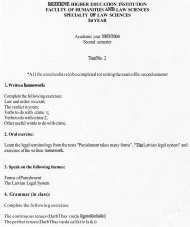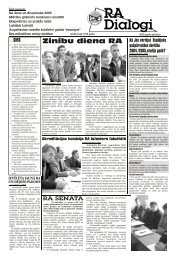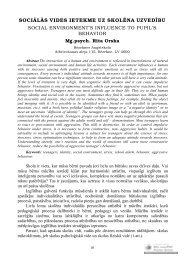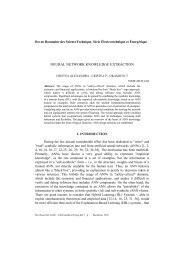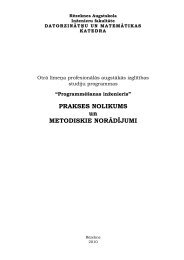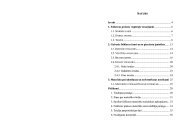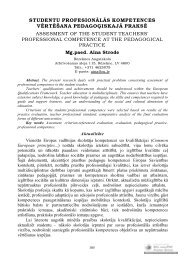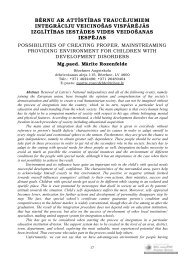- Page 1 and 2:
TEAMFLY
- Page 6:
Data Mining Techniques For Marketin
- Page 10:
To Stephanie, Sasha, and Nathaniel.
- Page 16:
xx Acknowledgments And, of course,
- Page 20:
TEAMFLY Team-Fly ®
- Page 24:
xxiv Introduction Even if the techn
- Page 30:
Contents Acknowledgments About the
- Page 34:
Contents vii Learning Things That A
- Page 38:
Contents ix Different Kinds of Chur
- Page 42:
Contents xi Chapter 8 How Does a Ne
- Page 46:
Contents xiii Case Study: Who Is Us
- Page 50:
Contents xv Chapter 14 Data Mining
- Page 54:
Contents xvii Availability of Train
- Page 58:
CHAPTER 1 Why and What Is Data Mini
- Page 62:
Why and What Is Data Mining? 3 In t
- Page 66:
Why and What Is Data Mining? 5 many
- Page 70:
Why and What Is Data Mining? 7 DATA
- Page 74:
Why and What Is Data Mining? 9 Clas
- Page 78:
Why and What Is Data Mining? 11 cho
- Page 82:
Why and What Is Data Mining? 13 man
- Page 86:
Why and What Is Data Mining? 15 Com
- Page 90:
Why and What Is Data Mining? 17 sit
- Page 94:
Why and What Is Data Mining? 19 And
- Page 100:
22 Chapter 2 Data is at the heart o
- Page 104:
24 Chapter 2 Marketing literature f
- Page 108:
26 Chapter 2 What Is the Virtuous C
- Page 112:
28 Chapter 2 that lurking inside th
- Page 116:
30 Chapter 2 possible to identify t
- Page 120:
32 Chapter 2 All of these measureme
- Page 124:
34 Chapter 2 Data mining results ch
- Page 128:
36 Chapter 2 Quota Savings Randomiz
- Page 132:
38 Chapter 2 Some of these fields r
- Page 136:
40 Chapter 2 How Data Mining Was Ap
- Page 140:
42 Chapter 2 smaller group of likel
- Page 144:
44 Chapter 3 years, the authors hav
- Page 148:
46 Chapter 3 Ford is the only one w
- Page 152:
48 Chapter 3 Figure 3.2 shows anoth
- Page 156:
50 Chapter 3 The data mining method
- Page 160:
52 Chapter 3 In the most general se
- Page 164:
54 Chapter 3 of maleness. It seems
- Page 168:
56 Chapter 3 Step One: Translate th
- Page 172:
58 Chapter 3 ■■ ■■ ■■ C
- Page 176:
60 Chapter 3 Data mining is often p
- Page 180:
62 Chapter 3 These operational syst
- Page 184:
64 Chapter 3 Often, variables that
- Page 188:
66 Chapter 3 90% 80% 70% 60% 50% 40
- Page 192:
68 Chapter 3 advantage as smarter p
- Page 196:
70 Chapter 3 Including Multiple Tim
- Page 200:
72 Chapter 3 People often find it h
- Page 204:
74 Chapter 3 When missing values mu
- Page 208:
76 Chapter 3 category, such as bake
- Page 212:
78 Chapter 3 Step Eight: Assess Mod
- Page 216:
80 Chapter 3 Percent of Row Frequen
- Page 220:
82 Chapter 3 An example helps to ex
- Page 224:
84 Chapter 3 Lift Value 1.5 1.4 1.3
- Page 228:
86 Chapter 3 before. The newly disc
- Page 232:
88 Chapter 4 comes from traditional
- Page 236:
90 Chapter 4 based on price will no
- Page 240:
92 Chapter 4 The problem with this
- Page 244:
94 Chapter 4 DATA BY CENSUS TRACT T
- Page 248:
96 Chapter 4 Actually, the first le
- Page 252:
98 Chapter 4 ROC CURVES Models are
- Page 256:
100 Chapter 4 The upper, curved lin
- Page 260:
102 Chapter 4 BENEFIT (continued) A
- Page 264:
104 Chapter 4 A smaller, better-tar
- Page 268:
106 Chapter 4 Reaching the People M
- Page 272:
108 Chapter 4 Difference in respons
- Page 276:
110 Chapter 4 Among the most useful
- Page 280:
112 Chapter 4 More typically, a bus
- Page 284:
114 Chapter 4 Nonrepayment of debt
- Page 288:
116 Chapter 4 Making Recommendation
- Page 292:
118 Chapter 4 Retention campaigns c
- Page 296:
120 Chapter 4 information than simp
- Page 300:
122 Chapter 4 From a data mining pe
- Page 304:
124 Chapter 5 What is remarkable an
- Page 308:
126 Chapter 5 TIP The simplest expl
- Page 312:
128 Chapter 5 Time Series Histogram
- Page 316:
130 Chapter 5 The Central Limit The
- Page 320:
132 Chapter 5 A QUESTION OF TERMINO
- Page 324:
134 Chapter 5 small probability. Pr
- Page 328:
136 Chapter 5 Cross-Tabulations Tim
- Page 332:
138 Chapter 5 In addition, various
- Page 336:
140 Chapter 5 the challenger offer.
- Page 340:
142 Chapter 5 Table 5.2 The 95 Perc
- Page 344:
144 Chapter 5 Table 5.3 The 95 Perc
- Page 348:
146 Chapter 5 What the Confidence I
- Page 352:
148 Chapter 5 says that with contro
- Page 356:
150 Chapter 5 The appeal of the chi
- Page 360:
152 Chapter 5 distribution depends
- Page 364:
154 Chapter 5 Table 5.7 Chi-Square
- Page 368:
156 Chapter 5 Table 5.8 Chi-Square
- Page 372:
158 Chapter 5 100% 80% 60% 40% 20%
- Page 376:
160 Chapter 5 There Is a Lot of Dat
- Page 380:
162 Chapter 5 Figure 5.11 shows ano
- Page 386:
CHAPTER 6 Decision Trees Decision t
- Page 390:
Decision Trees 167 thinks of a part
- Page 394:
Decision Trees 169 Scoring Figure 6
- Page 398:
Decision Trees 171 50% tot units de
- Page 402:
Decision Trees 173 The first split
- Page 406:
Decision Trees 175 the best splits,
- Page 410:
Decision Trees 177 Purity and Diver
- Page 414:
Decision Trees 179 Entropy Reductio
- Page 418:
Decision Trees 181 COMPARING TWO SP
- Page 422:
Decision Trees 183 statistical rela
- Page 426:
Decision Trees 185 The CART Pruning
- Page 430:
Decision Trees 187 COMPARING MISCLA
- Page 434:
Decision Trees 189 Picking the Best
- Page 438:
Decision Trees 191 The trees grown
- Page 442:
Decision Trees 193 WARNING Small no
- Page 446:
Decision Trees 195 Taking Cost into
- Page 450:
Decision Trees 197 Voter #1 and Vot
- Page 454:
Decision Trees 199 Neural Trees One
- Page 458:
Decision Trees 201 part of the targ
- Page 462:
Decision Trees 203 Decision Trees i
- Page 466:
Decision Trees 205 Applying Decisio
- Page 470:
Decision Trees 207 USING DECISION T
- Page 474:
Decision Trees 209 enjoyed using th
- Page 480:
212 Chapter 7 probing neural networ
- Page 484:
214 Chapter 7 of the value of the p
- Page 488:
216 Chapter 7 Table 7.1 Common Feat
- Page 492:
218 Chapter 7 Year_Built (1923), su
- Page 496:
220 Chapter 7 The solution is to in
- Page 500:
222 Chapter 7 Feed-forward networks
- Page 504:
224 Chapter 7 magnitude of the weig
- Page 508:
226 Chapter 7 Feed-Forward Neural N
- Page 512:
228 Chapter 7 last purchase age gen
- Page 516:
230 Chapter 7 TRAINING AS OPTIMIZAT
- Page 520:
232 Chapter 7 networks now takes se
- Page 524:
234 Chapter 7 Size of Training Set
- Page 528:
236 Chapter 7 This transformation (
- Page 532:
238 Chapter 7 Features with Ordered
- Page 536:
240 Chapter 7 be mapped to -1.0, -0
- Page 540:
242 Chapter 7 pattern the network f
- Page 544:
244 Chapter 7 1.0 B B B B A A B 0.0
- Page 548:
246 Chapter 7 Notice that the time-
- Page 552:
248 Chapter 7 2. Measure the output
- Page 556:
250 Chapter 7 The output units comp
- Page 560:
252 Chapter 7 unknown instance is f
- Page 564:
254 Chapter 7 The story continues w
- Page 570:
CHAPTER 8 Nearest Neighbor Approach
- Page 574:
Memory-Based Reasoning and Collabor
- Page 578:
Memory-Based Reasoning and Collabor
- Page 582:
Memory-Based Reasoning and Collabor
- Page 586:
Memory-Based Reasoning and Collabor
- Page 590:
Memory-Based Reasoning and Collabor
- Page 594:
Memory-Based Reasoning and Collabor
- Page 598:
Memory-Based Reasoning and Collabor
- Page 602:
Memory-Based Reasoning and Collabor
- Page 606:
Memory-Based Reasoning and Collabor
- Page 610:
Memory-Based Reasoning and Collabor
- Page 614:
Memory-Based Reasoning and Collabor
- Page 618:
Memory-Based Reasoning and Collabor
- Page 622:
Memory-Based Reasoning and Collabor
- Page 626:
Memory-Based Reasoning and Collabor
- Page 630:
CHAPTER 9 Market Basket Analysis an
- Page 634:
Market Basket Analysis and Associat
- Page 638:
Market Basket Analysis and Associat
- Page 642:
Market Basket Analysis and Associat
- Page 646:
Market Basket Analysis and Associat
- Page 650:
Market Basket Analysis and Associat
- Page 654:
Market Basket Analysis and Associat
- Page 658:
Market Basket Analysis and Associat
- Page 662:
Market Basket Analysis and Associat
- Page 666:
Market Basket Analysis and Associat
- Page 670:
Market Basket Analysis and Associat
- Page 674:
Market Basket Analysis and Associat
- Page 678: Market Basket Analysis and Associat
- Page 682: Market Basket Analysis and Associat
- Page 686: Market Basket Analysis and Associat
- Page 690: Market Basket Analysis and Associat
- Page 694: Market Basket Analysis and Associat
- Page 698: CHAPTER 10 Link Analysis The intern
- Page 702: Link Analysis 323 four people, all
- Page 706: Link Analysis 325 Bananas Red Leaf
- Page 710: Link Analysis 327 WHY DO THE DEGREE
- Page 714: Link Analysis 329 This lack of scal
- Page 718: Link Analysis 331 cannot be part of
- Page 722: Link Analysis 333 a link to Harvard
- Page 726: Link Analysis 335 Hubs Authorities
- Page 732: 338 Chapter 10 353 3658 00:00:41
- Page 736: 169 44 61 340 Chapter 10 The proces
- Page 740: 342 Chapter 10 USING SQL TO COLOR A
- Page 744: 5 MOU 344 Chapter 10 customer behav
- Page 748: 346 Chapter 10 Second, link analysi
- Page 754: CHAPTER 11 Automatic Cluster Detect
- Page 758: Automatic Cluster Detection 351 the
- Page 762: Automatic Cluster Detection 353 The
- Page 766: Automatic Cluster Detection 355 the
- Page 770: Automatic Cluster Detection 357 X 2
- Page 774: Automatic Cluster Detection 359 thi
- Page 778: Automatic Cluster Detection 361 DIS
- Page 782:
Automatic Cluster Detection 363 Man
- Page 786:
Automatic Cluster Detection 365 Use
- Page 790:
Automatic Cluster Detection 367 The
- Page 794:
Automatic Cluster Detection 369 sub
- Page 798:
Automatic Cluster Detection 371 Dis
- Page 802:
Automatic Cluster Detection 373 is
- Page 806:
Automatic Cluster Detection 375 sig
- Page 810:
Automatic Cluster Detection 377 Cre
- Page 814:
Automatic Cluster Detection 379 Pop
- Page 818:
Automatic Cluster Detection 381 Les
- Page 822:
CHAPTER 12 Knowing When to Worry: H
- Page 826:
Hazard Functions and Survival Analy
- Page 830:
Hazard Functions and Survival Analy
- Page 834:
Hazard Functions and Survival Analy
- Page 838:
Hazard Functions and Survival Analy
- Page 842:
Hazard Functions and Survival Analy
- Page 846:
Hazard Functions and Survival Analy
- Page 850:
Hazard Functions and Survival Analy
- Page 854:
Hazard Functions and Survival Analy
- Page 858:
1 Hazard Functions and Survival Ana
- Page 862:
Hazard Functions and Survival Analy
- Page 866:
Hazard Functions and Survival Analy
- Page 870:
Hazard Functions and Survival Analy
- Page 874:
Hazard Functions and Survival Analy
- Page 878:
Hazard Functions and Survival Analy
- Page 882:
Hazard Functions and Survival Analy
- Page 886:
Hazard Functions and Survival Analy
- Page 890:
Hazard Functions and Survival Analy
- Page 894:
Hazard Functions and Survival Analy
- Page 900:
422 Chapter 13 problems involving c
- Page 904:
424 Chapter 13 template for the hum
- Page 908:
426 Chapter 13 generation n generat
- Page 912:
428 Chapter 13 SIMPLE OVERVIEW OF G
- Page 916:
430 Chapter 13 Table 13.3 The Popul
- Page 920:
432 Chapter 13 Table 13.5 The Popul
- Page 924:
434 Chapter 13 So far, this problem
- Page 928:
436 Chapter 13 schema match the cor
- Page 932:
438 Chapter 13 The Schema Theorem e
- Page 936:
440 Chapter 13 The first problem fa
- Page 940:
442 Chapter 13 trained to fill in a
- Page 944:
444 Chapter 13 Figure 13.7 The Gena
- Page 948:
446 Chapter 13 Lessons Learned Gene
- Page 952:
448 Chapter 14 has largely replaced
- Page 956:
450 Chapter 14 NO CUSTOMER RELATION
- Page 960:
452 Chapter 14 ■■ ■■ Automa
- Page 964:
454 Chapter 14 Such agent relations
- Page 968:
456 Chapter 14 Larger businesses, o
- Page 972:
458 Chapter 14 Subscription Relatio
- Page 976:
Respond from Some Channel Not Pay 4
- Page 980:
462 Chapter 14 Who Are the Prospect
- Page 984:
464 Chapter 14 What Is the Role of
- Page 988:
466 Chapter 14 New sales come in th
- Page 992:
468 Chapter 14 AN ENGINE FOR CHURN
- Page 996:
470 Chapter 14 Winback Once custome
- Page 1000:
TEAMFLY Team-Fly ®
- Page 1004:
474 Chapter 15 believe that, over t
- Page 1008:
476 Chapter 15 The level of abstrac
- Page 1012:
478 Chapter 15 effort. One of the g
- Page 1016:
480 Chapter 15 WHAT IS A RELATIONAL
- Page 1020:
482 Chapter 15 WHAT IS A RELATIONAL
- Page 1024:
484 Chapter 15 warehouse must be re
- Page 1028:
486 Chapter 15 One or more of these
- Page 1032:
488 Chapter 15 Central Repository T
- Page 1036:
490 Chapter 15 BACKGROUND ON PARALL
- Page 1040:
492 Chapter 15 important type of da
- Page 1044:
494 Chapter 15 The data warehouse i
- Page 1048:
496 Chapter 15 In the middle are of
- Page 1052:
498 Chapter 15 Shop Date Product sh
- Page 1056:
500 Chapter 15 The third type of cu
- Page 1060:
502 Chapter 15 ranges of customer v
- Page 1064:
504 Chapter 15 Conformed Dimensions
- Page 1068:
506 Chapter 15 In diagrams, the dim
- Page 1072:
508 Chapter 15 One of the problems
- Page 1076:
510 Chapter 15 graph. Neural networ
- Page 1080:
512 Chapter 15 A typical data wareh
- Page 1084:
514 Chapter 16 A Customer-Centric O
- Page 1088:
516 Chapter 16 data is not readily
- Page 1092:
518 Chapter 16 Operational Data (bi
- Page 1096:
520 Chapter 16 Collecting the Right
- Page 1100:
522 Chapter 16 devising new product
- Page 1104:
524 Chapter 16 direct mail decrease
- Page 1108:
526 Chapter 16 A new data mining gr
- Page 1112:
528 Chapter 16 Scoring is not compl
- Page 1116:
530 Chapter 16 three major modules,
- Page 1120:
532 Chapter 16 What is appealing ab
- Page 1124:
534 Chapter 16 account future growt
- Page 1128:
536 Chapter 16 Comprehensible Outpu
- Page 1132:
538 Chapter 16 step is to create a
- Page 1136:
540 Chapter 17 budget for buying ha
- Page 1140:
542 Chapter 17 It is perhaps unfort
- Page 1144:
544 Chapter 17 The distribution of
- Page 1148:
546 Chapter 17 Before ignoring a co
- Page 1152:
548 Chapter 17 Figure 17.4 Angoss K
- Page 1156:
550 Chapter 17 ■■ True numeric
- Page 1160:
552 Chapter 17 Dates and Times Date
- Page 1164:
554 Chapter 17 Neural networks and
- Page 1168:
556 Chapter 17 One of the most impo
- Page 1172:
558 Chapter 17 Constructing the Cus
- Page 1176:
560 Chapter 17 Identifying the Cust
- Page 1180:
562 Chapter 17 business customers o
- Page 1184:
564 Chapter 17 Making Progress Alth
- Page 1188:
566 Chapter 17 Changes over Time Pe
- Page 1192:
568 Chapter 17 DM TM WEB Credit Car
- Page 1196:
570 Chapter 17 When the lookup tabl
- Page 1200:
572 Chapter 17 Pivoting Regular Tim
- Page 1204:
574 Chapter 17 Summarizing Transact
- Page 1208:
576 Chapter 17 One method of calcul
- Page 1212:
578 Chapter 17 TIP When many differ
- Page 1216:
580 Chapter 17 Revolvers, Transacto
- Page 1220:
582 Chapter 17 Table 17.5 Six Credi
- Page 1224:
584 Chapter 17 Table 17.6 Potential
- Page 1228:
586 Chapter 17 $2,000 $1,500 $1,000
- Page 1232:
588 Chapter 17 120 Payment as Multi
- Page 1236:
590 Chapter 17 The Dark Side of Dat
- Page 1240:
592 Chapter 17 Dirty Data Dirty dat
- Page 1244:
594 Chapter 17 and so on. However,
- Page 1248:
596 Chapter 17 varies from tool to
- Page 1252:
598 Chapter 18 Getting Started The
- Page 1256:
600 Chapter 18 These are areas wher
- Page 1260:
602 Chapter 18 proof-of-concept pro
- Page 1264:
604 Chapter 18 Although the details
- Page 1268:
606 Chapter 18 less likely to churn
- Page 1272:
608 Chapter 18 from one record to a
- Page 1276:
610 Chapter 18 are appropriate for
- Page 1280:
612 Chapter 18 serial number and ph
- Page 1284:
614 Chapter 18 plan allows. Since t
- Page 1288:
616 Index analysis differential res
- Page 1292:
618 Index auxiliary information, 56
- Page 1296:
620 Index champion-challenger appro
- Page 1300:
622 Index creative process, data mi
- Page 1304:
624 Index data (continued) missing
- Page 1308:
626 Index discrete outcomes, classi
- Page 1312:
628 Index genetic algorithms case s
- Page 1316:
630 Index intuition, data explorati
- Page 1320:
632 Index memory-based reasoning (M
- Page 1324:
634 Index new customer information
- Page 1328:
636 Index proof-of-concept projects
- Page 1332:
638 Index response, survey response
- Page 1336:
640 Index SQL data, time series ana
- Page 1340:
642 Index testing (continued) KS (K




